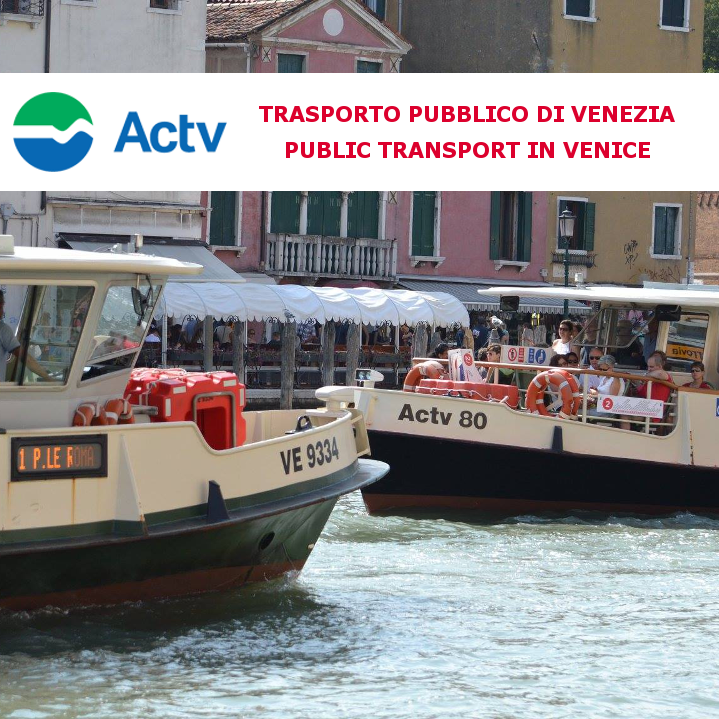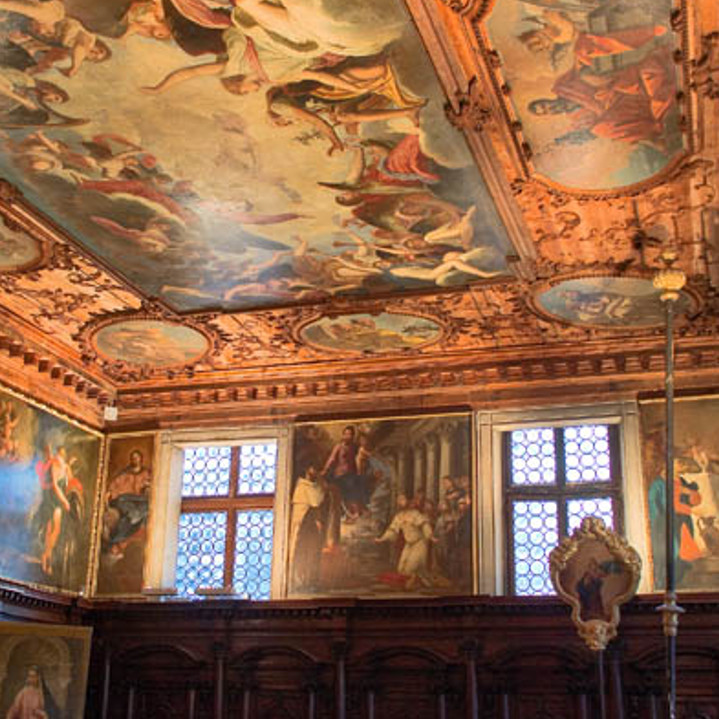You are here
San Polo medieval: courtesans, merchants and devotion
San Polo medieval: courtesans, merchants and devotion
This itinerary takes place in the Sestiere of San Polo, it starts by Rialto Bridge and ends to the Scuola Grande di San Rocco.
Still now there are in this district several artisanal activities like in the old days: you could visit three workshops that still continue with the Venetian traditions, Tabinotabi, a boutique of clothings on natural fabrics made according the ancient weaving techniques, Bluemoon Venice, a masks’ workshop where the “mascarer”- the mask maker - will make you discover the secrets of these so fascinating accessories and finally Monica Daniele, a boutique/workshop of hats and “tabarri” the cloaks of Venetians aristocrats.
The itinerary will make you discover one of the 6 Sestieri of the city where you will have the opportunity to know about Venetian history and traditions, for example the area of Rialto’s market that had been so important for its economical and social development since the time of the city’s foundation.
A particular attention is given to the Venetian devotion including the Frari (Franciscan friars) Basilica and the Scuola di San Rocco, one of the six “Scuole Grandi", Venetian merchants brotherhoods that had created a very efficient welfare system giving assistance and support to poor, sick and disinherited persons.
The Site “Venice and its Lagoon” has been inscribed on the World Heritage List since 1987 due to its Outstanding Universal Value, therefore it belongs to all of us: it is our common duty to respect it and preserve it so that it may be passed on to future generations.
The cultural heritage of the Site goes beyond the walls of palaces, churches, beyond islands and the lagoon, but is also memory, identity, community, all fundamental elements for the its vitality.
In 2017 the City launched the #EnjoyRespectVenezia campaign to raise awareness of tourists impact among visitors and invite them to maintain respectful and polite behavior during their stay, respecting the city and its inhabitants: it is important for example to walk keeping on the right, not to stop or sit on the bridges, not to feed the birds, to observe a behavior in keeping with the place you are visiting.
- Duration: about 3 hours and 40 minutes according to some eventual variations due to weather, visitor’s interest regarding certain parts of the itinerary and little resting pauses
- Lenght: approximately 2 Km
- Mode of travel: the itinerary takes place entirely on foot
- Recommended period: all year round. In case of “acqua alta” (high tide) walkways are previewed
- Accessibility: persons with reduced mobility are advised to take vaporetto line 1 from “Rialto mercato” stop to “San Toma” from where they will easily get Frari Basilica and Scuola Grande di San Rocco whithout finding bridges on their way. In the Scuola di San Rocco there is a stairlift to go up to the 1th flor rooms
- Departure: Rialto Bridge
- Arrival: Scuola Grande di San Rocco
- Districts: San Polo and Santa Croce (Calle dell’Agnella and Bonvicini)
-
Punti di interesse:
1) Bridge and Rialto area (buildings, history, traditions, typical cooking)
2) Calli - tiny backstreets - of Castelletto (medieval Venice history, traditions and toponymy)
3) Basilica Santa Maria Gloriosa dei Frari
4) Scuola Grande di San Rocco - Interconnection with other itineraries: "Trade and power between Rialto e San Marco"
Listen to the audio tour

Chiesa di San Giacometo
ph. Giorgio Bombieri - Comune di Venezia

Calle de la Comedia
ph. Gabriele Vattolo - Comune di Venezia
Starting point: Rialto Bridge
This walk starts by Rialto Bridge - the symbol of Venetian merchants power - built on wood at the end of c11 in order to link the two shores of the Grand Canal and at the same time to connect the political power center - Saint Mark's Square - to the most important commercial site, Rialto market.
The name comes from the Latin “rivus altus” and means the highest part of the lagoon islands where since the beginning of Venice history were sold the most precious and prized items protecting them from the high tides: in few years the area became the most important and fabulous market in Europe.
The bridge was built under the Doges Pasquale Cicogna by the architect Antonio Da Ponte between 1588 and 1592 to replace the wooden drawbridges that since c12 were continuously rebuilt: with the shops on both of its sides Rialto Bridge can be considered a kind of ancient mall.

Rialto Bridge
ph. Giorgio Bombieri - Comune di Venezia
Stage 1: From Rialto Bridge to the boutique Tabinotabi (30 minutes)
Down the bridge on the left side there is the c16 Sottoportego degli Oresi with its frescos painted vaulting ceiling: it was here where there were the most splendid, precious and famous Venetian jewelry shops.
When Henry III of France was in Venice in 1574, he fell in love with a gold and precious stones scepter, but the jeweler refused to sell the precious item because the king didn’t have enough money…probably the jeweler knew that soon another and richer king could spend the money he was asking for the precious object.
Still now under the arcades of the Sottoportego there are many shops and it is here where you find the sophisticate boutique Tabinotabi, specialized on clothing and accessories made on natural and ecological fabrics, as the Tabinotabi, which is a fiber of seaweed: this fabric is so elegant and soft as silk and the clothings are very sophisticate and at the same time compatible with the environment.

Sotoportego degli Oresi
ph. Gabriele Vattolo - Comune di Venezia
Stage 2: From Campo di Rialto to Calle del Scaleter, including the handmade Venetian masks workshop Bluemoon (1 hour and 15 minutes)
From Sottoportego degli Oresi you go to Campo di Rialto surrounded by Fabriche Vecchie, once seat of State Commerce, Administration and Navigation magistrates, built between 1520 and 1522 by Scarpagnino.
In the Campo there is the church of San Giacomo di Rialto: the tradition says that it was first built in 421 A.D. and it is considered the most ancient church of Venice: it is an 11th structure and part of the original material remains still make part of the building even after the church was restored in 1531: the Gothic portico is the only remaining one of its kind in Venice.
The Doge used to come to visit San Giacomo every year in memory of the indulgences granted by the Pope Alessandro III in 1177 and the church was always reserved to the merchants.
Several times rebuilt and definitely restored in 1531, the church was always reserved to the merchants of Rialto.
On the other side of the Campo you see the Porticato of Banco Giro (the name comes from the Banco Giro, a circulating credit bank, established here in 12th) and the Colonna del Bando, the proclamations stone called Gobbo di Rialto (hunchback stone) from 16th. The other proclamations stone stands by the facade of Saint Mark.
You go on walking to Ruga degli Oresi that goes through the ancient market just to arrive to Ruga dei Spezieri (spices’ merchants) and then you arrive to Campo delle Becarie: this was the place of the butcheries and little slaughters for mittens and lambs imported from Dalmatia or Greece.
In this part of the market had always been sold the most common alimentary products as fish, meet and vegetable: the traditional Venetian cooking still has several meals made with ewe’s meet like the “castradina” which is a kind of soup made of smoked mutton meet and cabbage typical for the day of Madonna della Salute (the celebration of the plague’s end in 1630) and the “castrà ragù” (mutton meet sauce) with gnocchi.
In this area had been shot several very well-known movies as The Tourist with Johnny Depp and Angiolina Jolie, The Merchant of Venice with Al Pacino and on the opposite side of the Grand Canal the famous scene of Casino Royal with Daniel Craig as James Bond with the palace that blew up…Fortunately, only in the movie!
On the other side of the bridge at the end of the Campo you walk through Calle del Capeler (the hats maker) where you will visit the mask workshop Bluemoon Venice: here the artisan will explain and show to you the secrets of the Venetian mask handcraft.
After this visit you go back and on the other side of the bridge you enter in Sottoportego Do Spade where still exists the ancient homonymous tavern where Casanova organized a memorable joke at the expense of the husband of a beautiful woman: the story and all the the details are written by the same Casanova in his “Memories of my life”.
Now you enter in the labyrinth of medieval streets where you can still feel the ancient atmosphere: walking through Calle della Donzella (by the name of an old tavern) you are in the “Castelletto”, a group of houses and streets located near the church of San Matteo where the prostitutes were contained by the State in order to attract men “distracted by sodomy”: whatever the story could had been, all kind of prostitutes and courtesans played here their trade.
You then find Campiello Albrizzi from the name of the 17th palace belonging to a family of fabrics merchants.
If you take Calle del Rio Terà (filled Canal) de Ca’ Rampani or “Carampani” (from the name of the family that there owned some houses) you will get Ponte delle Tette, the bridge where the prostitutes were allowed to expose their naked breasts painted on carmine: for that the term “carampana” was used in Venice to define a prostitute.
You continue through Calle dell’Agnella where, looking at the left side, you see Calle del Teatro from the ancient theatre of San Cassiano and finally you find Calle Bonvicini, just after Ponte dell’Agnella.

Pescheria, Mercato di Rialto
ph. Comune di Venezia
Stage 3: Calle del Scaleter and workshop of Monica Daniele (25 minutes)
At the end of Calle Bonvicini that takes its name from the family who lived here, after Calle Larga and then Calle del Cristo you arrive to Calle del Scaleter: this name, pretty common for Venetian streets in all the Sestieri, reminds the medieval Venetian bakers who used to make little donuts with the drawing of a ladder imprinted on it.
Here, in Calle del Scaleter, there is the workshop of Monica Daniele, an artisan who creates hats and traditional Venetian cloaks.

Calle del Scaleter
ph. Gabriele Vattolo - Comune di Venezia
Stage 4: Basilica Santa Maria Gloriosa dei Frari (40 minutes)
After the pleasant stop at the atelier, you continue the walk through Rio Terà Secondo, Campo Sant’Agostino and Campo San Stin until the Basilica Santa Maria Gloriosa dei Frari (Franciscan Friars) that really deserves a visit to know the masterpieces of Gothic and Renaissance art as the paintings of Titian and Giovanni Bellini.
In 1229 the Doge Jacopo Tiepolo gave to the Venetian Franciscan community a land to build a church, but the one you see now was rebuilt between 1340 and 1443 and it is a great example of conventual Gothic architecture: the outside building is simple and almost poor according to the rules of sobriety of the Franciscan order, otherwise the inside is rich on masterpieces of art that decorate the private chapels and alters belonging to the rich families of the Sestiere or to some city brotherhoods.
In the main chapel, on the high altar there is the extraordinary Assumption executed by Titian in 1518: few years later he painted a Pala for the Pesaro altar while in the in the Pesaro Chapel you see the Pala by Giovanni Bellini representing the Blessed Mary with the Child and Saints.
In the middle of the church there is the choir, fine work entirely c15 that has both Gothic and Renaissance elements.
The mausoleum of Titian was wanted by the Emperor of Austria and the tomb of Antonio Canova (where is sheltered the sculptor heart) was designed by the sculptor himself on the model of the tomb he had made for Maria Cristina of Habsburg in the Augustinians Church of Vienna.

Basilica dei Frari
ph. Giorgio Bombieri - Comune di Venezia
Stage 5: Campo San Rocco: Church and Scuola Grande di San Rocco (60 minutes)
Behind the Basilica you find Campo San Rocco with the church built in 1489 to house the relics of the French Saint.
The cult of this saint was very important because he was a protector from the plague, scourge that stroke most of European countries in those years.
Few years after the church, a merchants brotherhood untitled to Saint Roch was founded: it had been one of the richest and most influent ones in town, making part of the six Scuole Grandi (Main brotherhoods).
This kind of institutions, created by the rich middle-class merchants, used to accomplish charity actions according to the 7 Acts of Mercy: in this way the merchants could both show off and create a very efficient welfare system that eliminated almost for good poverty in Venice.
The Renaissance building was made by project of Bon and accomplished by Scarpagnino, it is inside decorated by a cycle of huge paintings on canvas - teleri - according to the Scuole practice.
Jacopo Tintoretto had been working for the Scuola during 24 years, between 1564 and 1588 and his paintings that cover the walls and ceilings of the rooms, allegorically represent the charity actions performed by the Scuola’s members by some of the most important moments of Old and New Testament.

Chiesa e Scuola Grande di San Rocco
ph. Giorgio Bombieri - Comune di Venezia
Useful information
- Squares and rest areas: In this itinerary there are not equipped resting and stopping areas even if it is possible to find places to rest with bars and coffee shops, for example Campo di Rialto, Sant'Agostin, San Stin, Frari and San Rocco: it is important to remember some of the most important points of #EnjoyRespectVenezia campaign as not to seat on the bridge steps, to pic-nic, to feed the birds and always keep a respectful behavior regarding the city and its monuments.
- Pay Public toilets facilities: the only public toilet facilities along this itinerary is at the start, in Campo Rialto Novo.
- Public drinking fountains: in Campo di San Giacomo di Rialto and in Erbaria





